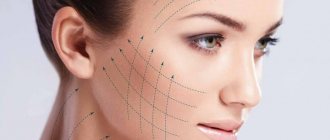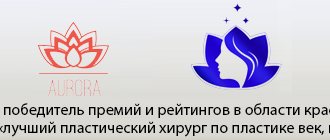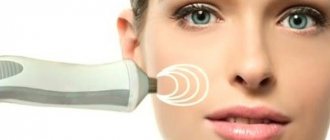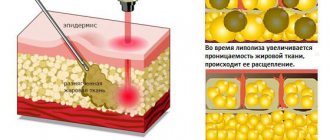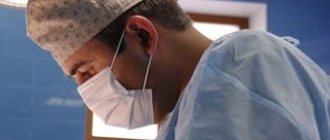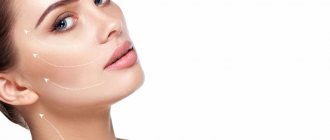Today, facial rejuvenation surgeries come in so many variations that many patients are lost in the terminology. In addition to the well-known classic facelift, check-lifting, S-lifting, G-lifting, U-lifting and other types of surgical operations designed to eliminate aesthetic imperfections have appeared. A not common, but quite effective technique is MAX lifting (MACS Lift). Let's talk about it in more detail.
The MAX lifting technique was developed more than 10 years ago by the Belgian surgeon
Dr. Patrick Tonnard
. Today, it is used by many plastic surgeons specializing in facial rejuvenation, although, of course, there are specialists who deny the effectiveness of mini-lifts.
MAX-lift is essentially very close to SMAS-lifting, only less traumatic
due to less detachment.
On the one hand, this allows the patient to avoid such extensive post-operative swelling and long-term recovery as with SMAS lifting. On the other hand, the rejuvenating effect of MAX lifting is less pronounced
than that of SMAS lifting.
What is MAX lifting and what are the anatomical features of the method?
The MAX-lifting technique was developed more than 10 years ago in Colombia by plastic surgeon Patrick Tonnard, and later American doctors began to use it in the United States. This method of rejuvenation quickly gained adherents among plastic surgeons due to the natural appearance of the patient and the lack of influence on facial expressions. Currently, more and more Russian doctors are using this type of rejuvenation, paying tribute to its benefits.
MACS lift is an acronym for “minimal access cranial suspension lift,” which literally means “minimal access facelift.” The method itself occupies a middle or compromise position between traditional facelift and SMAS lift, which is carried out only in the area of the aponeurosis. With MAX lifting, the surgeon excises excess skin and also tightens the deep structures of the face.
MAX-method: what is it?
The developer of MAX technology is practicing Colombian surgeon Patrick Tonnard. He managed to invent a technology that is characterized by minimal injury and maximum efficiency. Lifting is carried out by vertical tightening of the SMAS layer (muscular aponeurotic system located under the dermis and fatty tissue) and skin.
During the procedure, minimal tissue detachment is performed, which allows the patient to quickly go through the rehabilitation period and reduces the risk of complications.
The operation is performed to correct age-related changes in the lower two thirds of the face, where degenerative processes most quickly manifest themselves.
What is the difference between traditional lifting and lifting-MAX
- The incision made during the operation runs from the hairline above the ear, along the front surface at the level of the tragus, and ends in the area of the earlobe. With the conventional lift method, the incision continues behind the ear, which is much more traumatic for the patient.
- After the incision, the skin layer is usually tightened by peeling it off. The area of skin exfoliation is minimized and extends only to part of the cheek. Due to the reduction in the volume of the lift, there are far fewer postoperative complications and side effects.
- The muscular aponeurotic superficial layer (SMAS) is pulled up vertically and fixed with special purse-string sutures to the tissues of the temporal region. This manipulation allows you to straighten the nasolabial folds and correct the jawline.
- The aponeurosis is not exfoliated during this operation, so in the postoperative period there is no such formidable complication as impaired conduction of the facial nerve. The amount of swelling and hemorrhage in the surgical area is also reduced.
- A cheek lift can be performed simultaneously with lifting or blepharoplasty of the lower and upper eyelids, forehead and eyebrows.
Also in the section: Thread lifting (APTOS threads, Silhouette Lift, Golden threads)
What is the difference between MAX-lifting and other anti-aging procedures?
In our case, the cosmetologist makes a thin incision that starts at the place where the hair grows above the ear and ends at the lobe. In other cases, the incision is made behind the ear, and this is considered very traumatic.
Usually, after the incision, doctors tighten the skin layer by minimal peeling, which extends only to the side of the cheek. During this period, the volume of the tightening is sufficiently reduced, which contributes to the absence of serious complications and adverse reactions.
To tighten the muscular aponeurotic surface layer, specialists make a vertical incision, rather than a horizontal one, as in other cases. After this, it is fixed to the temporal tissues using a special purse-string suture. In this way, doctors straighten nasolabial folds and correct the jawline.
Compared to other operations, during MAX lifting the aponeurosis does not peel off. Therefore, rehabilitation is quick, easy and without serious complications, namely, without damage to the facial nerves, swelling and hemorrhage.
If such rejuvenation is intended to tighten the cheek area, then it can be combined with blepharoplasty or lifting of the lower and upper eyelids, frontal and eyebrow areas.
Advantages of the method
Undoubtedly, MAX-lifting has a number of advantages and undeniable advantages. Let's list them:
- The method is safe and most effective.
- With a minimal incision, maximum results are achieved when sagging the middle and lower parts of the face.
- This method corrects the angle between the neck and lower jaw.
- Using vertical sutures, you can smooth out the nasolabial fold.
- The method gives excellent results in tightening the cheek area and supporting the lower eyelid.
- The rehabilitation period has fewer complications and is much shorter in time.
- After this operation, facial features look natural, natural facial expressions are preserved.
- The method of suturing visually pulls the eyes towards the cheekbones and makes the look open.
Advantages of performing MAX-lifting at the Medical Club clinic
Performing the MAX-lifting operation at the Medical Club clinic has a number of advantages over other surgical methods for lifting facial tissue:
- this is an absolutely safe and highly effective method;
- the maximum lifting effect is achieved with minimal incisions;
- the rehabilitation period after MAX-lifting is shorter than after a traditional lift;
- After the operation, natural facial expressions and features are preserved.
MAX-lifting is a highly effective surgical method of face lifting, which makes it possible to achieve a pronounced rejuvenation effect with minimal trauma to facial tissue.
This operation is performed especially effectively by specialists from the Medical Club clinic, who guarantee not only absolute safety and the best result of the operation, but also provide the most comfortable conditions for the entire period of the patient’s treatment. Read more about facelift methods in the “Plastic Surgery” section on estet-portal.com. Thank you for staying with us!
Indications for MAX-lifting
The optimal age when MAX lifting can be performed is 35-55 years, when some age-related changes appear. So, the indications for surgery are as follows:
- Changing the oval and facial features.
- Descent of soft tissues of the lower and middle areas of the face.
- Decreased turgor and elasticity of the skin in the face and neck.
- Drooping corners of the mouth and deep nasolabial folds.
If the patient has pronounced age-related changes, then the MACS lift is combined with other types of face and neck lift.
SMAS and MAX lifting are effective methods of facial rejuvenation
A highly effective way in the fight for a youthful face is facelift. This plastic surgery allows you to restore a clear oval face, smooth out wrinkles, and tighten your neck. The method of performing this plastic surgery differs in each specific case. In this article I want to look at the two most popular facelift methods - SMAS lifting (SMAS) and max lifting (MACS). Very often patients want to know what the difference is between them.
SMAS lifting is a plastic surgery to lift the face, during which the subcutaneous aponeurotic muscle layer (SAMS) is moved to the correct position . Rejuvenation in this way can be carried out at any age if there are indications, while maintaining all facial expressions and previous facial features.
Max lifting is a more gentle method for lifting the middle and lower areas of the face. With this surgical technique, minimal incisions are made, and the oval of the face and chin are delicately tightened.
Contraindications
This type of intervention is not recommended if the patient has one of the contraindications, which include:
- Changes in the blood clotting process.
- Individual predisposition to the appearance of keloid scars.
- Diseases of the heart and blood vessels.
- Pregnancy and breastfeeding period.
At least 2 weeks before surgery, patients are advised to quit smoking or reduce the number of cigarettes smoked by 50%. You should also stop taking blood thinning medications (dietary supplements - ginkgo biloba, medications with aspirin) 10-12 days before surgery.
Rehabilitation
As after any intervention by a plastic surgeon, swelling and bruising may appear on the face for several days, which disappear within 1-2 weeks. Sutures are removed 10–12 days after surgery, which depends on the speed of tissue healing in each individual patient. For 2 weeks, the patient is not recommended to visit the sauna, bathhouse, sunbathe or engage in strenuous physical exercise. After this, the person can return to work and their normal lifestyle.
The initial results of lifting can be assessed after 1-2 weeks, but the full effect of lifting can be assessed only after 2 months.
Carrying out the operation
MAX face lifting has a number of features, and the operation itself is performed under general or local anesthesia. The stages of the operation are as follows:
- Making an incision in the area of the tragus of the auricle.
- Skin separation and aponeurosis tightening.
- Application of vertical purse-string sutures to the muscle frame.
- Excision of excess areas of skin.
- Applying cosmetic sutures to the incision site.
Rehabilitation period
Within a few days, swelling and bruising may appear on the face, which disappear within 1-2 weeks. Sutures are removed 7-10 days after surgery, which depends on the speed of tissue healing in each individual patient. For 2 weeks, the patient is not recommended to visit the sauna, bathhouse, sunbathe or engage in strenuous physical exercise. After this, the person can return to work, leading a normal lifestyle.
Early lifting results can be noticed already in 1-2 weeks, but the effect continues to increase up to 2 months.
The patient's condition on the 6th day after surgery
Possible complications
Due to the low level of injury, the number of complications with this type of lifting is minimal. Despite the fact that no plastic surgery can stop time, the effect of MACS lifting can last for 3-5 years.
What other rejuvenation methods and surgical techniques can the operation be combined with?
MAX-lifting is perfectly combined with other anti-aging procedures if there are indications and significant age-related changes:
- Endoscopic lifting of the upper third of the face, including the forehead, eyebrows and upper eyelids.
- Chin liposuction.
- Plastic surgery of the neck muscles.
In conclusion, it should be noted that the popularity of the MACS lift technique is only increasing every year, since it is characterized by a high level of effectiveness, low traumatism and a short postoperative period with a minimum number of complications.
MAX-lifting technique
Max lifting is a worthy alternative to the traditional circular facelift, Smas plastic. The peculiarity of this type of lifting is that, unlike the popular circular facial plastic surgery, during Max-lifting not only the skin, but also the muscles are tightened. With Max-lifting, the muscular frame of the face is affected, but no less than, for example, with Smas-lifting.
The Max-lifting procedure is performed through a small incision along the tragus of the auricle. Next, the soft tissues of the face are separated and the aponeurosis is tightened. The muscular frame is supported by special sutures placed there. The results of the operation are visible immediately, but swelling and bruising may persist for 7-14 days.
Indications
The optimal age for a MAX lift is considered to be 30-50 years. It is at this time that changes already appear in the area of the middle and lower third of the face. Plastic surgeons recommend the technique in the presence of the following indications:
- blurred oval face;
- drooping tissue in the lower two-thirds of the face;
- sagging of the dermis, including in the neck area;
- pronounced nasolabial folds;
- drooping corners of the lips.
It is noteworthy that during the lift, the temporal area is not affected, but the look visually becomes more open. For pronounced defects, MAX can be combined with other rejuvenation techniques, for example, blepharoplasty, endoscopic forehead lifting, which helps raise eyebrows, chin liposuction, etc.
Combining different techniques allows you to achieve good results even with pronounced age-related changes.
